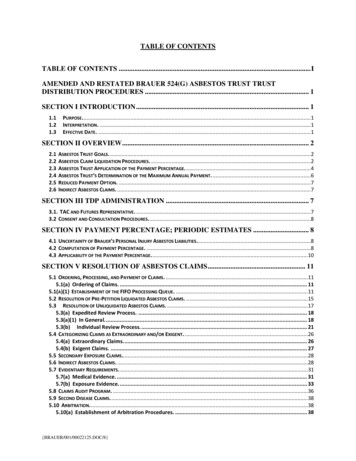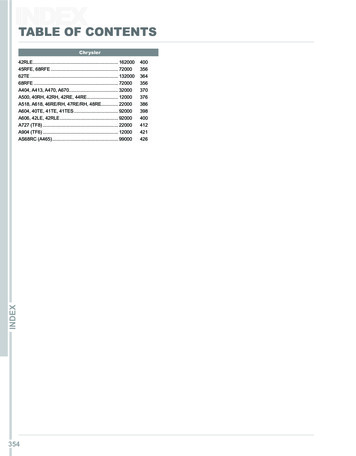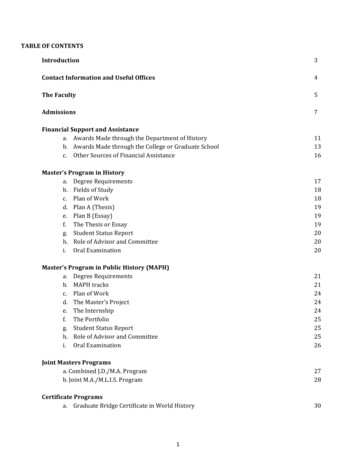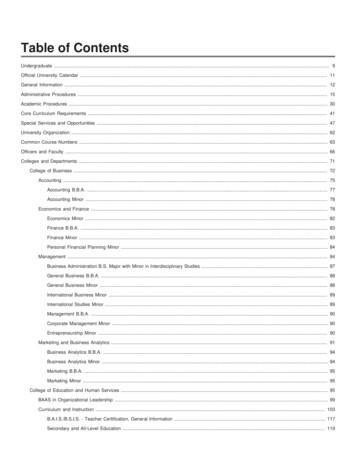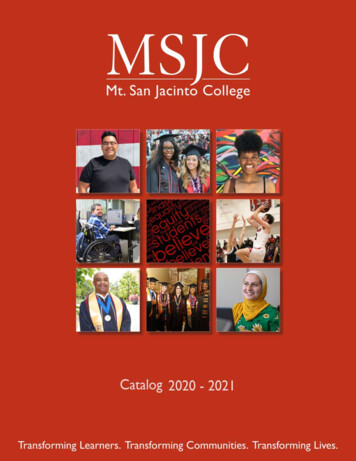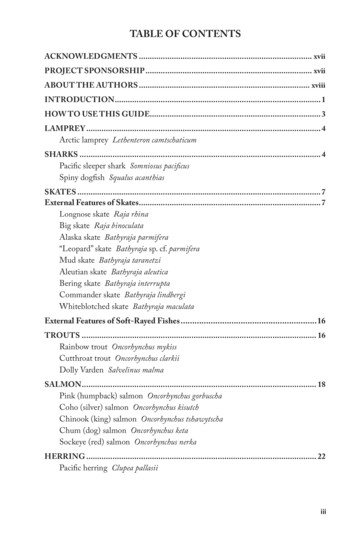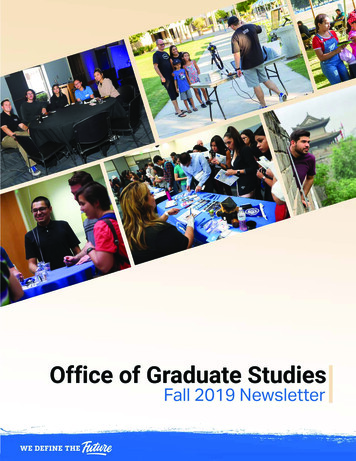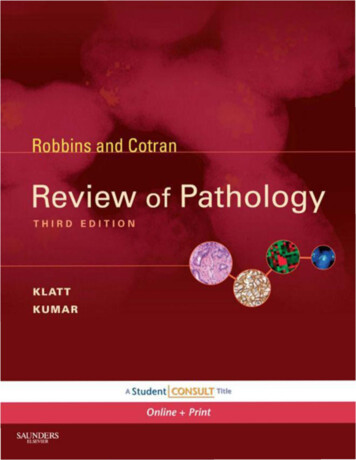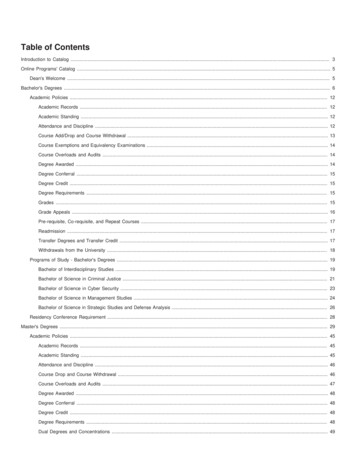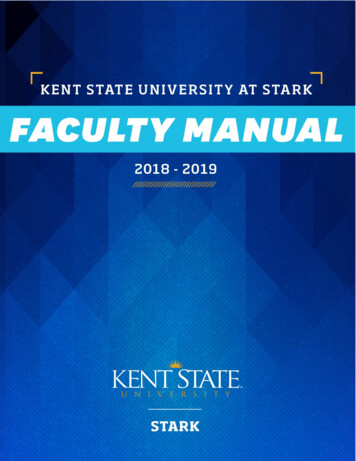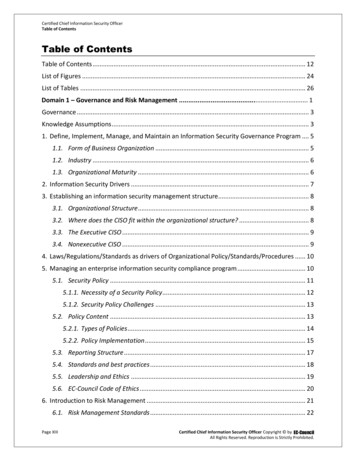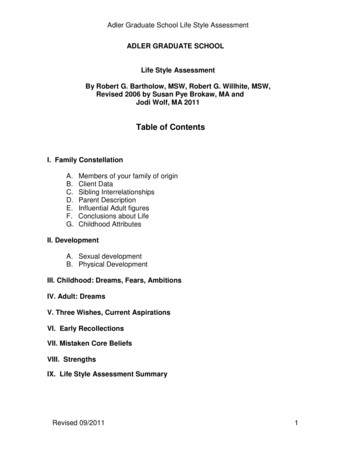
Transcription
Adler Graduate School Life Style AssessmentADLER GRADUATE SCHOOLLife Style AssessmentBy Robert G. Bartholow, MSW, Robert G. Willhite, MSW,Revised 2006 by Susan Pye Brokaw, MA andJodi Wolf, MA 2011Table of ContentsI. Family ConstellationA.B.C.D.E.F.G.Members of your family of originClient DataSibling InterrelationshipsParent DescriptionInfluential Adult figuresConclusions about LifeChildhood AttributesII. DevelopmentA. Sexual developmentB. Physical DevelopmentIII. Childhood: Dreams, Fears, AmbitionsIV. Adult: DreamsV. Three Wishes, Current AspirationsVI. Early RecollectionsVII. Mistaken Core BeliefsVIII. StrengthsIX. Life Style Assessment SummaryRevised 09/20111
Adler Graduate School Life Style AssessmentClient’s NameDateTherapistI. Family ConstellationAnswer Sections A thru G from your perspective as a child,A. Members of your family of origin: Give Name and a Brief Description of each family member,including yourself.Parent: Include Biological and Step Parent (if applicable)NameFatherBrief DescriptionMotherStep Father orMotherChildren: (Include all brothers and sisters, in order of birth from oldest to youngest,including yourself). Also include and indicate miscarriages, stillborn, and deceasedsiblings along with half and step siblings if applicable.)Revised 09/20112
Adler Graduate School Life Style AssessmentGenogram WorksheetComplete per standard procedureRevised 09/20113
Adler Graduate School Life Style AssessmentB. Data on client as a child:1Who was most like you?In what ways?2Who was most differentfrom you?In what ways?3Grade school information:Attitude about school?Favorite subject?Least liked subject?Social situation?Teachers pet?4Sports interests or skills?5Childhood habits?6When a child, who hadhealth problems, physicalor emotional?7*As a child, did you feel thatboys or girls hadadvantages over the other?8*If a female, were you atomboy in childhood?9*If male, did you think ofyourself as a sissy?10Childhood spiritual orreligious experiences, ifany?Revised 09/20114
Adler Graduate School Life Style Assessment11Did you, or any familymember(s), experience anyabuse (within or outsidethe family)? Give client optionEmotionalPhysicalSexualYesNoYesNoYesNoto pass if so desires at this time.If so:Who?By whom? / Elaborate12Who was most spoiled?By whom?How and for what reason?13Who was most punished?By whom?How and for what reason?14Who in the family neededto be right? /Explain15Who in the family felt keenabout fairness andunfairness? /Explain16Your role in peer group?(leader, middler, follower,outsider)? /Explain17Childhood talents oraccomplishments?Revised 09/20115
Adler Graduate School Life Style AssessmentC. Sibling Interrelationships:1Who took care of whom?2Who played with whom?3Who got along best withwhom?4Who fought and arguedthe most?5Who was helpful at home?6Who made mischief?ExplainD. Description of your Parents and Step Parent (if applicable)FatherStep Father MotherStep Mother1. Current age if living2. If deceased, when3. Age when client born4. EducationRevised 09/20116
Adler Graduate School Life Style Assessment6. Personality: traitsadmired, liked, disliked,feared7. What was mostimportant to them?8. What behavior orattitude could win theirpraise?9. What made themangry?10. What ways did theyinfluence you?11. What were theirexpectations of thechildren?Did you go along withor do opposite?12. Relationship withthe children?13. Relationship withyou?14. Which child wasmost like each parent?How?Revised 09/20117
Adler Graduate School Life Style Assessment15. Were you distantfrom either parent?Why?16. In whom did youconfide in/ closest to?17. To whom did yougo for comfort /support? Why?18. What kind ofrelationship did yourparents have?19. Who was dominant,made decisions; overtand covert?20. Did they agree ondiscipline and raisingthe children?21. Method ofdisciplining used?22. Did they quarrelopenly?About What?23. How did thequarrels end?Revised 09/20118
Adler Graduate School Life Style Assessment24. How did yourparents solveproblems?E. Additional adult figures who had a significant influence on your childhoodWho?Describe the relationship?How did it influence you?F. Conclusions about Life; Considering your answers to the questions (A-E), whatdid you learn about what conclusions you made as a child about:Yourself?What males are like?What females are like?Whatmarriage/relationshipis like?What parenting is like?What family life islike?Revised 09/20119
Revised 09/2011Adler Graduate School Life Style AssessmentFamily Constellation WorksheetBullet point the significant characteristics/findings that stand out fromLife Style Assessment Section I (A-F)10
Adler Graduate School Life Style AssessmentG. Childhood AttributesUsing the following Childhood Attribute Assessment (page 11), rate yourself and yoursiblings from the perspective you had as a child. Put the name and /- age of each child, including yourself in the box above thecolumns. Rate, (not rank) yourself and only those siblings who are within 5 years older oryounger than yourself. Rate only the attributes that each person is either (H) High or (L) Low in.Transfer the significant characteristics to the Childhood AttributeWorksheet.Revised 09/201111
csAchievement &SuccessAdler Graduate School Life Style AssessmentChildhood Attribute AssessmentIntelligenceGradesIndustriousStandards re.AchievementTried to PleaseSucceeded PleasingConsiderateTried to be GoodSelfishObedientOpenly RebelledCovertly RebelledStandards re.Right/WrongCritical of SelfAssertiveBossy-DominatingDemanded WayGot WaySense of PersistentExcitement SeekerDaringComplainedResponsibleWithdrawnChip on ShoulderPunishedSpoiledPamperedSuccessfulHelped at HomeLooksMoodyUsed OthersSociableSought AttentionCritical of OthersPerfectionistTried to be bornSensitivePitied selfHeld GrudgesSelf ConfidentInsecureNeatGave Up EasilyDependentIndependentEasy GoingImpulsiveCautiousWorrierSelf EsteemInferiority FeelingsHid FeelingsAthleticMasculine*Feminine*Revised 09/201112
Adler Graduate School Life Style AssessmentSignificant Childhood Attribute WorksheetBullet point only the High and any significant Low characteristics/findings that stand out fromLife Style Assessment Section I (G)Revised 09/201113
Adler Graduate School Life Style AssessmentFamily Constellation Interpretation WorksheetLife Style Assessment Section I (A-G)Self Concept:“I am”Beliefs about myself;What I am/doWhat I likeMy Self imageRevised 09/2011Self Ideal:“I should be” or “not be”Beliefs about myself;What I want to be/ should beWhat I ought to doMy Self idealEnvironmental Evaluation:“Life is”Beliefs outside of self;What men, women, people areWhat the world, life is likeWhat I expect from people, life14Ethical Convictions:Ethical & moral “I should”(May/may not be society’s beliefs/values)Beliefs about;What is proper, right & wrong;What I expect from myself and/orothers
Adler Graduate School Life Style AssessmentII. DevelopmentA. Sexual development:1. When did you first notice your sexual development?2. How did you feel about it? Why?3. Were you prepared for it?4. When did you first have; if female - menstruation? If male- nocturnal emission?Were you prepared for it?How did you feel about it? Why?Have you had; if female - menstrual difficulties?if male- erectile dysfunction?*5. If a boy, were you told you should have been a girl?*6. If a girl, were you told you should have been a boy?Revised 09/201115
Adler Graduate School Life Style Assessment7. Review and of all 7 starred (*) LS Assessment items for gender beliefs andguiding lines to determine indication of Masculine Protest8. As an adult have you experienced any sexual problems?9. What is your sexual orientation? Heterosexual Homosexual Bi-sexual Trans-sexualHow do you feel about your orientation?B. Physical Development:1. Any childhood health problems?If so, how were you treated by others?2. How did you see your body image?3. Did you have any disabilities?Revised 09/201116
Adler Graduate School Life Style AssessmentGender Guiding Line WorksheetBullet point the significant characteristics/findings that stand out fromLife Style Assessment Sections I (A-G) and II (A-B)Revised 09/201117
Adler Graduate School Life Style AssessmentGender Guiding Line Interpretation WorksheetLife Style Assessment Sections I (A-G) and II (A-B)Self Concept:“I am”Beliefs about myself;What I am/doWhat I likeMy Self imageRevised 09/2011Self Ideal:“I should be” or “not be”Beliefs about myself;What I want to be/ should beWhat I ought to doMy Self idealEnvironmental Evaluation:“Life is”Beliefs outside of self;What men, women, people areWhat the world, life is likeWhat I expect from people, life18Ethical Convictions:Ethical & moral “I should”(May/may not be society’s beliefs/values)Beliefs about;What is proper, right & wrong;What I expect from myself and/orothers
Adler Graduate School Life Style AssessmentIII.Childhood Dreams, Fears, Ambitions:Childhood DreamsoDream Collection Instructions: Recall the earliest dream recollection(s), preferably before age 8. Using Childhood Dream Recollection blank sheet below, writedown the dream as described, including the specific incidents orhappenings, no matter how inconsequential it seems.Collect:The DreamThe feelingThe reason for the feelingThe most vivid moment/snap shotThe feeling at that momentThe reason for that feelingoComplete the Childhood Dream Interpretation Worksheet for thedream(s) to identify the beliefs; both accurate and mistaken.oDetermine the strengths revealed in the dream(s) and add them to list onthe Strength Worksheet.Childhood Dream RecollectionRevised 09/201119
Adler Graduate School Life Style AssessmentChildhood Dream Interpretation WorksheetLife Style Assessment Section IIISelf Concept:“I am”Beliefs about myself;What I am/doWhat I likeMy Self imageRevised 09/2011Self Ideal:“I should be” or “not be”Beliefs about myself;What I want to be/ should beWhat I ought to doMy Self idealEnvironmental Evaluation:“Life is”Beliefs outside of self;What men, women, people areWhat the world, life is likeWhat I expect from people, life20Ethical Convictions:Ethical & moral “I should”(May/may not be society’s beliefs/values)Beliefs about;What is proper, right & wrong;What I expect from myself and/orothers
Adler Graduate School Life Style AssessmentChildhood Fears:Childhood Ambitions:As a child, how did you answer, “What do you want to be when you grow up”?IV.Adult DreamsAdult Dream RecollectionFollow the Childhood Dream Collection Instructions and Childhood Dream Interpretation Worksheet(Not required for class)V.Three Wishes:At this Point in Time:1.2.3.Current Aspirations:Revised 09/201121
Adler Graduate School Life Style AssessmentVI. Early Recollections Collect a total of three different Early Recollections (one each; using the Basic,Brokaw and Willhite Methods). Be sure to follow the specific collection andtransformation instructions given and demonstrated for each method.For each Recollection;oRecall the earliest recollection, preferably before age 8. Most people canrecall incidents around ages 4, 5, and 6; some earlier.oUsing the ER# blank worksheets, write down the ER as described,including the specific incidents or happenings, no matter howinconsequential it seems.Collect:The ERThe feelingThe reason for the feelingThe most vivid moment/snap shotThe feeling at that momentThe reason for that feelingoComplete the following Early Recollection # Interpretation Worksheetfor each ER according to the specific ER Method instructions in order toidentify the ER beliefs; both accurate and mistaken.oDetermine the strengths revealed in each one of the three ER’s and addthem to the Strength Worksheet.*For class purposes;oCompletely write out the ER on the corresponding LS Assessment ER #Blank Worksheet according to the Method required. BUT use anddiscuss only the pre transformational ER beliefs (not thetransformational beliefs) on the ER Worksheets and in the Life StyleSummary and the Life Style Analysis.Revised 09/201122
Adler Graduate School Life Style AssessmentEarly Recollection #1 Basic MethodWrite complete ER according to method handoutRevised 09/201123
Adler Graduate School Life Style AssessmentEarly Recollection # 1 Interpretation WorksheetLife Style Assessment Section VISelf Concept:“I am”Beliefs about myself;What I am/doWhat I likeMy Self imageRevised 09/2011Self Ideal:“I should be” or “not be”Beliefs about myself;What I want to be/ should beWhat I ought to doMy Self idealEnvironmental Evaluation:“Life is”Beliefs outside of self;What men, women, people areWhat the world, life is likeWhat I expect from people, life24Ethical Convictions:Ethical & moral “I should”(May/may not be society’s beliefs/values)Beliefs about;What is proper, right & wrong;What I expect from myself and/orothers
Adler Graduate School Life Style AssessmentEarly Recollection #2 Brokaw MethodWrite complete ER according to method handoutRevised 09/201125
Adler Graduate School Life Style AssessmentEarly Recollection #2 Interpretation WorksheetLife Style Assessment Section VISelf Concept:“I am”Beliefs about myself;What I am/doWhat I likeMy Self imageRevised 09/2011Self Ideal:“I should be” or “not be”Beliefs about myself;What I want to be/ should beWhat I ought to doMy Self idealEnvironmental Evaluation:“Life is”Beliefs outside of self;What men, women, people areWhat the world, life is likeWhat I expect from people, life26Ethical Convictions:Ethical & moral “I should”(May/may not be society’s beliefs/values)Beliefs about;What is proper, right & wrong;What I expect from myself and/orothers
Adler Graduate School Life Style AssessmentEarly Recollection #3 Willhite MethodWrite complete ER according to method handoutRevised 09/201127
Adler Graduate School Life Style AssessmentEarly Recollection #3 Interpretation WorksheetLife Style Assessment Section VISelf Concept:“I am”Beliefs about myself;What I am/doWhat I likeMy Self imageRevised 09/2011Self Ideal:“I should be” or “not be”Beliefs about myself;What I want to be/ should beWhat I ought to doMy Self idealEnvironmental Evaluation:“Life is”Beliefs outside of self;What men, women, people areWhat the world, life is likeWhat I expect from people, life28Ethical Convictions:Ethical & moral “I should”(May/may not be society’s beliefs/values)Beliefs about;What is proper, right & wrong;What I expect from myself and/orfrom others
Adler Graduate School Life Style AssessmentVII. Possible Mistaken Core Beliefs Worksheet (Always, Never, Only)Review all Life Style Assessment Sections and include only the core mistaken beliefs revealedSelf Concept“I am”Self Ideal“I should be” or “not be”Environmental Assessment“Men, women, people are”; life is”‘Revised 09/201129Ethical ConvictionsEthical and moral “I should”
Adler Graduate School Life Style AssessmentVerified Mistaken Core Beliefs Worksheet (Always, Never, Only)List only the core mistaken beliefs Verified by the Client after reviewing the Possible Mistaken Core Belief WorksheetSelf Concept“I am”Revised 09/2011Self Ideal“I should be” or “not be”Environmental Assessment“Men, women, people are”; life is”30Ethical ConvictionsEthical and moral “I should”
Adler Graduate School Life Style AssessmentVIII. STRENGTH WORKSHEETReview all Life Style Assessment Sections (including ER’s) and list client’s strengthsRevised 09/201131
Adler Graduate School Life Style AssessmentHUNCH WORKSHEETList hunches (1, 2, 3.) made from various sections of the Life Style AssessmentReview with client and mark as (V) Verified, (D) Dismissed or (C) Corrected and rewrite it according to client.HUNCH:1.VERIFIED or DISMISSED or CORRECTED1.Revised 09/201132
Adler Graduate School Life Style AssessmentIX. Life Style Assessment SummaryComplete this Life Style Assessment Summary using the information acquired from LSAssessment data; including the Genogram, Attribute, Family Constellation, Gender GuidingLine, Strengths, Dream and Early Recollection Interpretation Worksheets, along with theVerified Mistaken Core Beliefs and Hunch Worksheet. The summary is a bullet point format,highlighting only the significant information obtained from reviewing and pullingtogether data obtained from the worksheets. This is only an outline (not written paragraphs),and is the foundation for the final Life Style Analysis paper and aids in identifying andsummarizing Life Style Beliefs and the Fictive Goal which will be a written analysis in the finalpaper. (See Guideline packet for final paper requirements.)I.Family Constellation Birth Order: position, characteristics, etc.“Self Concept, Self Ideal” Parent models: regarding; gender, marriage/relationships, roles.“Environmental Evaluation”Revised 09/201133
Adler Graduate School Life Style Assessment Family Atmosphere: household climate; rules, parenting style, interactions betweensiblings and parents & children.“Environmental Evaluation” Family Values: importance or value placed on; ethnicity, family, religion, status,education, work, etc.“Ethical Convictions”Revised 09/201134
Adler Graduate School Life Style AssessmentII.Childhood AttributesBullet point list only the significant characteristics the client is either high or low in;looking for extremes and clusters to help in determining fictive goal and mistaken beliefs.III.Gender guiding lineBullet point list only the significant Family Constellation and Physical and SexualDevelopment influences on the clients Life Style regarding; gender beliefs, identity andsexual orientation.Revised 09/201135
Adler Graduate School Life Style AssessmentIV.Early Recollection and Dream Interpretation:Bullet point list only the significant beliefs and themes derived from the ER’s: ER #1 Interpretation ER #2 Interpretation ER #3 InterpretationRevised 09/201136
Adler Graduate School Life Style AssessmentV.Fictive Goal and the Mistaken Beliefs used to achieve it:I.Identifying Life style:* Everyone has the same Universal Goal and everyone has a single Fictive Goal. Thereare typically multiple Mistaken Beliefs supporting the one Fictive Goal. As acontinuation of above, list each of as many additional Mistaken Beliefs the client verified,as follows:(Universal Goal) In order to belong, be significant, safe/secure(Fictive Goal),I must be therefore (in conclusion)(Mistaken Belief) I mustalways, never, only.(Mistaken Belief) I must always, never, onlyVI.Strengths and Positive Qualities:Bullet point list only the strengths found in reviewing all the Life Style AssessmentSections (including ER’s) that the client can use to overcoming any difficulties resultingfrom Mistaken Beliefs that are interfering in their life.Additional Comments:Revised 09/201137
154Genograms in Family AssessmentAppendixPART 1: GENOGRAM FORMATB. Family interaction patterns. The following symbols are optional. Theclinician may prefer to note them on a separate sheet. They alre amongthe le'ast precise information on the genogram, but may be key indicators of relationship patterns the clinician wants to remember:A. Symbols to describe basic family membership and structure (includeon genogram significant others who lived. with or cared for familymembers - place them on the right side of the genogram with a notation about who they arl .)Mille:[JFemale:Index Peirson lIP):D155Veryc:lOSllrelationship:Distant rdationship:0Birth date - ; ) 43 -75,(;- Death dateConflktual relationship:0\1\1\1\00 . ·0Estrangemen t or cu t off(give dates if pOllsible):D-lf-OCutoH62-78lRlDellth Xa)D C)Fused' and conflictual:tv! arriage (give date)(Husband on left. wife on right): ,.fi09Living togetherrelat.ionship or Haiison:Marital sleparation (give date): ;.709Divorce (give
Adler Graduate School Life Style Assessment Revised 09/2011 11 G. Childhood Attributes Using the following Childhood Attribute Assessment (page 11), rate yourself and your siblings from the perspective you had as a child. Put th
